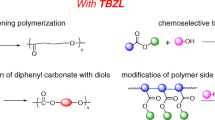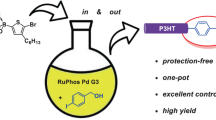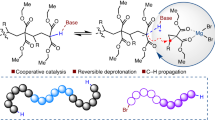Abstract
Catalyst-transfer systems have emerged in the condensative chain polymerization of AB-type monomers and stoichiometry-independent polycondensation of AA- and BB-type monomers to synthesize π-conjugated polymers. Although catalyst-transfer polycondensation (CTP) systems have often been explained by a ring-walking process of catalytic metals with a main chain, the functional-group effect of aromatic monomers on such CTP phenomena is unclear. In this study, stoichiometry-independent Migita–Kosugi–Stille coupling polycondensation was performed between 2,5-bis(trimethylstannyl)thiophene and an ester-functionalized dibromo monomer, which is bis(2-butyloctyl) 2,5-dibromoterephthalate, to obtain high-molecular-weight π-conjugated poly(phenylene thienylene) (Mn = 16,800). The method uses a 2-fold excess of the dibromo monomer toward the distannylated monomer. Such successful nonstoichiometric polycondensation may be derived from the intramolecular Pd(0) catalyst transfer on the aromatic dibromo monomer after the first coupling reaction between the dibromo monomer and stannylated compounds during polymerization. The results of model reactions and DFT calculations using ester-, ether- and alkyl-functionalized dibromo compounds suggest that incorporating the ester-carbonyl group into aromatic dibromo monomers is a key molecular design strategy to realize an efficient intramolecular Pd(0) catalyst-transfer system.
This is a preview of subscription content, access via your institution
Access options
Subscribe to this journal
Receive 12 print issues and online access
$259.00 per year
only $21.58 per issue
Buy this article
- Purchase on Springer Link
- Instant access to full article PDF
Prices may be subject to local taxes which are calculated during checkout




Similar content being viewed by others
References
Kline RJ, Mcgehee MD, Kadnikova EN, Liu J, Fréchet JMJ. Controlling the field-effect mobility of regioregular polythiophene by changing the molecular weight. Adv Mater. 2003;15:1519–22.
Bartelt JA, Douglas JD, Mateker WR, Labban AE, Tassone CJ, Toney MF, et al. Controlling solution-phase polymer aggregation with molecular weight and solvent additives to optimize polymer-fullerene bulk heterojunction solar cells. Adv Energy Mater. 2014;4:1301733.
Yokoyama A, Miyakoshi R, Yokozawa T. Chain-growth polymerization for poly(3-hexylthiophene) with a defined molecular weight and a low polydispersity. Macromolecules. 2004;37:1169–71.
Sheina EE, Liu J, Iovu MC, Laird DW, Mccullough RD. Chain growth mechanism for regioregular nickel-initiated cross-coupling polymerizations. Macromolecules. 2004;37:3526–8.
Miyakoshi R, Shimono K, Yokoyama A, Yokozawa T. Catalyst-transfer polycondensation for the synthesis of poly(p-phenylene) with controlled molecular weight and low polydispersity. J Am Chem Soc. 2006;128:16012–3.
Yokoyama A, Suzuki H, Kubota Y, Ohuchi K, Higashimura H, Yokozawa T. Chain-growth polymerization for the synthesis of polyfluorene via Suzuki−Miyaura coupling reaction from an externally added initiator unit. J Am Chem Soc. 2007;129:7236–7.
Bridges CR, Mccormick TM, Gibson GL, Hollinger J, Seferos DS. Designing and refining Ni(II)diamine catalysts toward the controlled synthesis of electron-deficient conjugated polymers. J Am Chem Soc. 2013;135:13212–9.
Tkachov R, Karpov Y, Senkovskyy V, Raguzin I, Zessin J, Lederer A, et al. Efficient tin-free route to a donor–acceptor semiconducting copolymer with variable molecular weights. Macromolecules. 2014;47:3845–51.
Yokozawa T, Ohta Y. Transformation of step-growth polymerization into living chain-growth polymerization. Chem Rev. 2016;116:1950–68.
Leone AK, Mueller EA, McNeil AJ. The history of palladium-catalyzed cross-couplings should inspire the future of catalyst-transfer polymerization. J Am Chem Soc. 2018;140:15126–39.
Goto E. Unpublished results. There are data and related descriptions about the model reaction between 3 and an equimolar of 4,9-dibromo-2,7-bis(2-hexyl)benzo[lmn][3,8]-phenanthroline-1,3,6,8-tetraone (13) under the typical Migita-Kosugi-Stille coupling reaction condition catalyzed by Pd2(dba)3/P(o-tolyl)3 in toluene, affording only the disubstituted product without producing the monosubstituted one, remaining the unreacted 13 (October 9, 2013, E. Goto’s laboratory notebook 2, p. 54). Based on this result and inspired by the known Pd(0) catalyst transfer system for nonstoichiometric polycondensation (ref. 4), the nonstoichiometric The Migita-Kosugi-Stille coupling polycondensation of 2 and 4,9-dibromo-2,7-bis(2-decyltetradecyl) benzo[lmn][3,8]-phenanthroline-1,3,6,8-tetraone (14) ([14]0/[2]0 = 1.25) was conducted to afford a high-molecular-weight polymer (November 5, 2013, E. Goto’s laboratory notebook 2, p. 68).
Goto E, Ando S, Ueda M, Higashihara T. Nonstoichiometric Stille coupling polycondensation for synthesizing naphthalene-diimide-based π-conjugated polymers. ACS Macro Lett. 2015;4:1004–7.
Terayama K, Goto E, Higashihara T. Nonstoichiometric Stille coupling polycondensation via an intramolecular Pd(0) catalyst transfer using excess phthalimide monomer. Macromol Chem Phys. 2018;219:1800175.
Nojima M, Kosaka K, Ohta Y, Yokozawa T. Precision synthesis of π-conjugated polymers by using intra-and intermolecular transfer of catalyst. Polym Prepr Jpn. 2015;64:1Pe025.
Nojima M, Kosaka K, Kato M, Ohta Y, Yokozawa T. Alternating intramolecular and intermolecular catalyst-transfer Suzuki-Miyaura condensation polymerization: Synthesis of boronate-terminated π-conjugated polymers using excess dibromo monomers. Macromol Rapid Commun. 2016;37:79–85.
Nojima M, Ohta Y, Yokozawa T. Additive-controlled switching from abnormal to normal unstoichiometric Suzuki–Miyaura polycondensation for poly(biphenylenevinylene). Chem Lett. 2017;46:35–37.
Sugita H, Nojima M, Ohta Y, Yokozawa T. Unusual cyclic polymerization through Suzuki–Miyaura coupling of polyphenylene bearing diboronate at both ends with excess dibromophenylene. Chem Commun. 2017;53:396–9.
Kosaka K, Nanjyo K, Ohta Y, Yokozawa T. Importance of the balance of interaction between palladium catalyst and aromatic π-face for unstoichiometric Suzuki-Miyaura coupling polymerization: effective Pd cataCXium A catalyst for fluorene and cyclopentadithiophene monomers. Chem Lett. 2018;47:1040–3.
Yokozawa T, Harada N, Sugita H, Ohta Y. Intramolecular catalyst transfer on a variety of functional groups between benzene rings in a Suzuki–Miyaura coupling reaction. Chem Eur J. 2019;25:10059–62.
Sugita H, Ohta Y, Yokozawa T. Synthesis of cyclic aromatic polymer containing thiophene or pyridine by means of unstoichiometric Suzuki-Miyaura cyclic polycondensation: Effect of the position of bromine of heteroarylenes on cyclic polycondensation. J Polym Sci. 2020;58:1236–40.
Nomura N, Tsurugi K, Okada M. Mechanistic rationale of a palladium-catalyzed allylic substitution polymerization—carbon−carbon bond-forming polycondensation out of stoichiometric control by cascade bidirectional allylation. Angew Chem Int Ed. 2001;40:1932–5.
Hempe M, Reggelin M. Molecular packing and morphological stability of dihydro-indeno[1,2-b]fluorenes in the context of their substitution pattern. RSC Adv. 2017;7:47183–9.
Brizius G, Pschirer NG, Steffen W, Stitzer K, Loye HC, Bunz UHF. Alkyne metathesis with simple catalyst systems: efficient synthesis of conjugated polymers containing vinyl groups in main or side chain. J Am Chem Soc. 2000;122:12435–40.
Bedard TC, Moore JS. Design and synthesis of molecular turnstiles. J Am Chem Soc. 1995;117:10662–71.
Kihara N, Komatsu S, Takata T, Endo T. Significance of stoichiometric imbalance in step polymerization via reactive intermediate. Macromolecules. 1999;32:4776–83.
Matsumoto K, Ogawa T, Jikei M. Nonstoichiometric polycondensation based on Friedel-Crafts acylation in superacids for the syntheses of aromatic polyketones. Polym Chem. 2017;8:7297–7300.
Bryan ZJ, Hall AO, Zhao CT, Chen J, McNeil AJ. Limitations of using small molecules to identify catalyst-transfer polycondensation reactions. ACS Macro Lett. 2016;5:69–72.
Mikami K, Nojima M, Masumoto Y, Mizukoshi Y, Takita R, Yokozawa T, et al. Catalyst-dependent intrinsic ring-walking behavior on π-face of conjugated polymers. Polym Chem. 2017;8:1708–13.
Bilbrey JA, Bootsma AN, Bartlett MA, Locklin J, Wheeler SE, Allen WD. Ring-walking of zerovalent nickel on aryl halides. J Chem Theory Comput. 2017;13:1706–11.
Zhang TX, Li ZA. DFT study on Pd-catalyzed Suzuki cross-coupling polycondensation of aryl bromide monomers. Comput Theor Chem. 2013;1016:28–35.
Murai S, Kakiuchi F, Sekine S, Tanaka Y, Kamatani A, Sonoda M, et al. Efficient catalytic addition of aromatic carbon-hydrogen bonds to olefins. Nature. 1993;366:529–31.
Acknowledgements
This work is mainly supported by the Tokuyama Science Foundation. KT appreciates the support from the Innovative Flex Course for Frontier Organic Material Systems (iFront) at Yamagata University. We thank Prof. Cheng-Liang Liu from the Department of Materials Science and Engineering at National Taiwan University (NTU) for helping to match this collaborative work between Japan and Taiwan.
Author information
Authors and Affiliations
Contributions
KT performed experiments on the synthesis of monomer and polymers as well as model reactions. C-WL performed experiments on DFT calculation. TH advised on the obtained results. All the authors prepared the manuscript.
Corresponding author
Ethics declarations
Conflict of interest
The authors declare no competing interests.
Additional information
Publisher’s note Springer Nature remains neutral with regard to jurisdictional claims in published maps and institutional affiliations.
Supplementary information
Rights and permissions
About this article
Cite this article
Terayama, K., Liu, CW. & Higashihara, T. Catalyst-transfer system in stoichiometry-independent AA+BB-type Migita–Kosugi–Stille coupling polycondensation using ester-functionalized dibromo monomer. Polym J 54, 143–150 (2022). https://doi.org/10.1038/s41428-021-00571-2
Received:
Revised:
Accepted:
Published:
Issue Date:
DOI: https://doi.org/10.1038/s41428-021-00571-2



